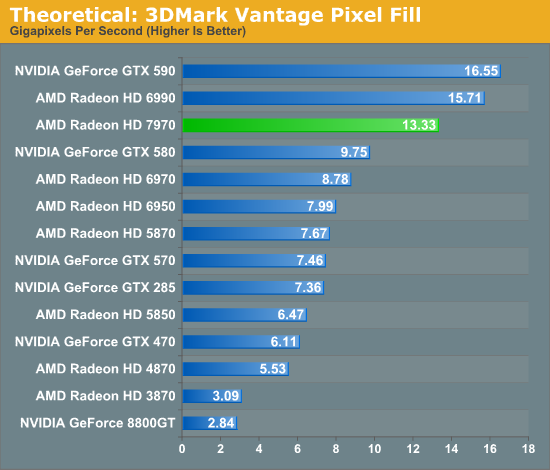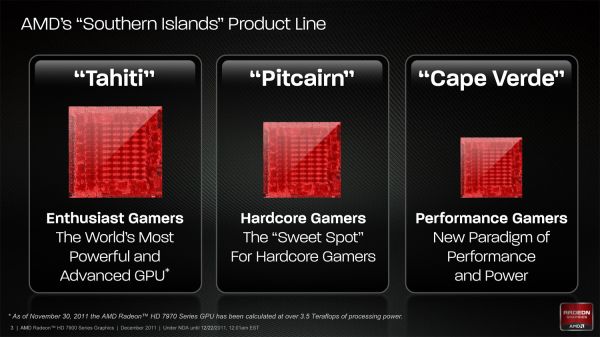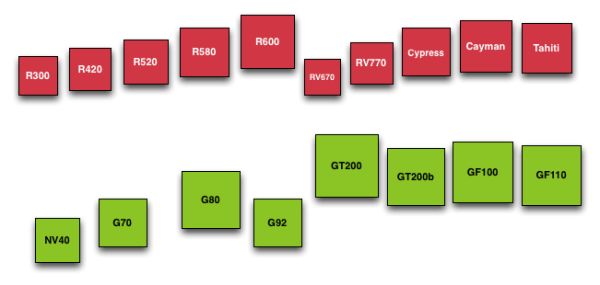AMD Radeon HD 7970 Review: 28nm And Graphics Core Next, Together As One
by Ryan Smith on December 22, 2011 12:00 AM EST- Posted in
- GPUs
- AMD
- Radeon
- ATI
- Radeon HD 7000
Building Tahiti & The Southern Islands
Now that we’ve had a chance to go over the basis of the Graphics Core Next architecture, let’s talk about the finished products.
Today AMD will be launching Tahiti, the first GPU of the Southern Islands family. Southern Islands will initially be composed of 3 GPUs: Tahiti, Pitcairn, and Cape Verde. Tahiti is the largest and most powerful member of the Southern Islands family, while Pitcairn and Cape Verde get progressively smaller. AMD has not yet announced the branding or launch dates for Pitcarn and Cape Verde, but it typically takes AMD around 6 months to launch a complete family. As such it’s reasonable to expect that all 3 GPUs will have launched by the end of June although there’s a good likelihood of it happening sooner than that.
All 3 GPUs are based on the GCN architecture, and as family members will have similar features while varying the number of functional units accordingly. Along with the architecture change Southern Islands brings with it a slew of additional features that we’ll get to in the following pages, including Partially Resident Texture (PRT) support, PCIe 3.0, FastHDMI, Direct3D 11.1, and AMD’s fixed-function H.264 encoder, the Video Codec Engine.
But today is all about Tahiti, so let’s get down to business.
As we quickly covered in our introduction, Tahiti is a 4.31B transistor GPU based on the GCN architecture and built on TSMC’s new 28nm High-K process. Due to TSMC canceling their 32nm process last year AMD has had to wait over 2 years for the next full node rather than taking advantage of the half-node process as they typically do, and as a result the jump from Cayman at 40nm to Tahiti at 28nm is much bigger than with past product launches. Whereas Cayman had 2.64B transistors and a die size of 389mm2, Tahiti has a whopping 63% more transistors than Cayman and yet it’s still smaller, coming in at a slightly more petite 365mm2.
At this point AMD hasn’t provided us with the typical board power values for 7970, but we do know that PowerTune is limited to 250W. In terms of design 7970 is clearly intended to work in similar environments as the 6970, in which case power consumption should be similar to the 6970.
Interestingly enough however we’re hearing that 7970 cards are proving to be very overclockable, which is a good sign for the state of TSMC’s 28nm process, and at the same time a bit distressing. Moore’s Law has continued to hold with respect to transistor density, but the power consumption benefits of using smaller nodes has continued to wane. Having a lot of overclocking headroom means that the 7970 has the potential to be much faster, but it also means that the 7970 (and 28nm GPUs in general) are going to be bottlenecked by power. In which case seeing as how we’re already approaching 300W with single-GPU video cards, the performance gains realized from future fabrication processes would be limited to the ever diminishing returns on power consumption improvements.
Diving deeper into Tahiti, as per the GCN architecture Tahiti’s 2048 SPs are organized into 32 Compute Units. Each of these CUs contains 4 texture units and 4 SIMD units, along with a scalar unit and the appropriate cache and registers. At the 7970’s core clock of 925MHz this puts Tahiti’s theoretical FP32 compute performance at 3.79TFLOPs, while its FP64 performance is ¼ that at 947GFLOPs. As GCN’s FP64 performance can be configured for 1/16, ¼, or ½ its FP32 performance it’s not clear at this time whether the 7970’s ¼ rate was a hardware design decision for Tahiti or a software cap that’s specific to the 7970. However as it’s obvious that Tahiti is destined to end up in a FireStream card we will no doubt find out soon enough.
Meanwhile the frontend/command processor for Tahiti is composed of 2 Asynchronous Command Engines (ACEs) and 2 geometry engines. Just as with Cayman each geometry engine can dispatch 1 triangle per clock, giving Tahiti the same theoretical 2 triangle/clock rate as Cayman. As we’ll see however, in practice Tahiti will be much faster than Cayman here due to efficiency improvements.
Looking beyond the frontend and shader cores, we’ve seen a very interesting reorganization of the rest of the GPU as opposed to Cayman. Keeping in mind that AMD’s diagrams are logical diagrams rather than physical diagrams, the fact that the ROPs on Tahiti are not located near the L2 cache and memory controllers in the diagram is not an error. The ROPs have in fact been partially decoupled from the L2 cache and memory controllers, which is also why there are 8 ROP partitions but only 6 memory controllers. Traditionally the ROPs, L2 cache, and memory controllers have all been tightly integrated as ROP operations are extremely bandwidth intensive, making this a very unusual design for AMD to use.
As it turns out, there’s a very good reason that AMD went this route. ROP operations are extremely bandwidth intensive, so much so that even when pairing up ROPs with memory controllers, the ROPs are often still starved of memory bandwidth. With Cayman AMD was not able to reach their peak theoretical ROP throughput even in synthetic tests, never mind in real-world usage. With Tahiti AMD would need to improve their ROP throughput one way or another to keep pace with future games, but because of the low efficiency of their existing ROPs they didn’t need to add any more ROP hardware, they merely needed to improve the efficiency of what they already had.
The solution to that was rather counter-intuitive: decouple the ROPs from the memory controllers. By servicing the ROPs through a crossbar AMD can hold the number of ROPs constant at 32 while increasing the width of the memory bus by 50%. The end result is that the same number of ROPs perform better by having access to the additional bandwidth they need.

The big question right now, and one we don’t have an answer to, is what were the tradeoffs for decoupling the ROPs? Clearly the crossbar design has improved ROP performance through the amount of memory bandwidth they can access, but did it impact anything else? The most obvious tradeoff here would be for potentially higher latency, but there may be other aspects that we haven’t realized yet.
On that note, let’s discuss the memory controllers quickly. Tahiti’s memory controllers aren’t significantly different from Cayman’s but there are more of them, 50% more in fact, forming a 384bit memory bus. AMD has long shied away from non-power of 2 memory busses, and indeed the last time they even had a memory bus bigger than 256bits was with the ill-fated 2900XT, but at this point in time AMD has already nearly reached the practical limits of GDDR5. AMD’s ROPs needed more memory bandwidth, but even more than that AMD needed more memory bandwidth to ensure Tahiti had competitive compute performance, and as such they had little choice but to widen their memory bus to 384bits wide by adding another 2 memory controllers.
It’s worth noting though that the addition of 2 more memory controllers also improves AMD’s cache situation. With 128KB of L2 cache being tied to each memory controller, the additional controllers gave AMD 768KB of L2 cache, rather than the 512KB that a 256bit memory bus would be paired with.














292 Comments
View All Comments
mczak - Thursday, December 22, 2011 - link
Oh yes _for this test_ certainly 32 ROPs are sufficient (FWIW it uses FP16 render target with alpha blend). But these things have caches (which they'll never hit in the vantage fill test, but certainly not everything will have zero cache hits), and even more important than color output are the z tests ROPs are doing (which also consume bandwidth, but z buffers are highly compressed these days).You can't really say if 32 ROPs are sufficient, nor if they are somehow more efficient judged by this vantage test (as just about ANY card from nvidia or amd hits bandwidth constraints in that particular test long before hitting ROP limits).
Typically it would make sense to scale ROPs along with memory bandwidth, since even while it doesn't need to be as bad as in the color fill test they are indeed a major bandwidth eater. But apparently AMD disagreed and felt 32 ROPs are enough (well for compute that's certainly true...)
cactusdog - Thursday, December 22, 2011 - link
The card looks great, undisputed win for AMD. Fan noise is the only negative, I was hoping for better performance out the new gen cooler but theres always non-reference models for silent gaming.Temps are good too so theres probably room to turn the fan speed down a little.
rimscrimley - Thursday, December 22, 2011 - link
Terrific review. Very excited about the new test. I'm happy this card pushes the envelope, but doesn't make me regret my recent 580 purchase. As long as AMD is producing competitive cards -- and when the price settles on this to parity with the 580, this will be the market winner -- the technology benefits. Cheers!nerfed08 - Thursday, December 22, 2011 - link
Good read. By the way there is a typo in final words.faster and cooler al at once
Anand Lal Shimpi - Thursday, December 22, 2011 - link
Fixed, thank you :)Take care,
Anand
hechacker1 - Thursday, December 22, 2011 - link
I think most telling is the minimum FPS results. The 7970 is 30-45% ahead of the previous generation; in a "worse case" situation were the GPU can't keep up or the program is poorly coded.Of course they are catching up with Nvidia's already pretty good minimum FPS, but I am glad to see the improvement, because nothing is worse than stuttering during a fasted pace FPS. I can live with 60fps, or even 30fps, as long as it's consistent.
So I bet the micro-stutter problem will also be improved in SLI with this architecture.
jgarcows - Thursday, December 22, 2011 - link
While I know the bitcoin craze has died down, I would be interested to see it included in the compute benchmarks. In the past, AMD has consistently outperformed nVidia in bitcoin work, it would also be interesting to see Anandtech's take as to why, and to see if the new architecture changes that.dcollins - Thursday, December 22, 2011 - link
This architecture will most likely be a step backwards in terms of bitcoin mining performance. In the GCN architecture article, Anand mentioned that buteforce hashing was one area where a VLIW style architecture had an advantage over a SIMD based chip. Bitcoin mining is based on algorithms mathematically equivalent to password hashing. With GCN, AMD is changing the very thing that made their card better miners than Nvidia's chips.The old architecture is superior for "pure," mathematically well defined code while GCN is targeted at "messy," more practical and thus widely applicable code.
wifiwolf - Thursday, December 22, 2011 - link
a bit less than expected, but not really an issue:http://www.tomshardware.co.uk/radeon-hd-7970-bench...
dcollins - Thursday, December 22, 2011 - link
You're looking at a 5% increase in performance for a whole new generation with 35% more compute hardware, increased clock speed and increased power consumption: that's not an improvement, it's a regression. I don't fault AMD for this because Bitcoin mining is a very niche use case, but Crossfire 68x0 cards offer much better performance/watt and performance/$.